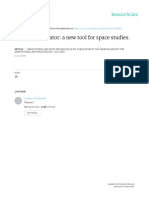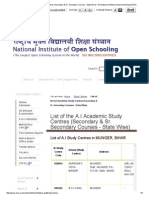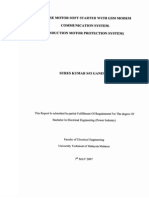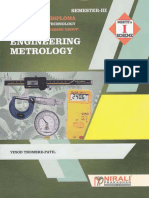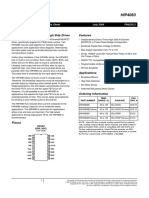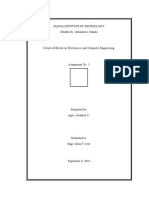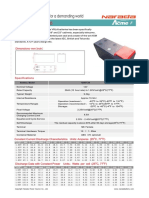Roadmapwkshp Lessard
Roadmapwkshp Lessard
Uploaded by
Iset LabOriginal Description:
Original Title
Copyright
Available Formats
Share this document
Did you find this document useful?
Is this content inappropriate?
Report this DocumentCopyright:
Available Formats
Roadmapwkshp Lessard
Roadmapwkshp Lessard
Uploaded by
Iset LabCopyright:
Available Formats
Sounding rockets as platforms for instrument and spacecraft technology development
How sounding rockets provide an effective testbed for technology development
Sounding rockets have long been the traditional development platform for space instrumentation. Many of the reliable and effective instruments currently in operation on various satellites have been developed, in part, on sounding rockets. The rocket program, through the LCAS portion of the ROSS announcement, provides annual opportunities for sciencedriven missions. While these missions are often used for instrument development, sounding rockets can also be used to develop spacecraft technology.
About sounding rockets
The various sounding rockets currently available through the LCAS program provide Altitudes from a few hundred kms to 1000+ kms. Telemetry at bandwidths that greatly exceed what is typically available on a satellite. Launches into high or low latitude regions (Poker Flat in Alaska, White Sands in New Mexico and Wallops Island in Virginia are routine; other locations possible on a campaign basis). A high degree of flexibility with regard to mission concepts. Flight times lasting ~15 minutes or more.
Types of missions
The objectives of any particular mission are driven by science. At the same time, the flexibility provided by a rocket is wellsuited to unique tasks. For example:
The Enstrophy mission, designed jointly by the University of New Hampshire and JPL, was both an auroral science mission and a feasibility test for ultra-low-resource sensorcraft. Each of 4 hockeypuck sized free-flyers carried a power and telemetry system, a magnetometer and sun sensors.These tiny spacecraft provided the opportunity to design within very low resource boundaries and to test the outcome in a realistic environment, while also providing new observations of spatial and temporal structure of auroral currents. In conjunction with the Johns Hopkins Astro-2 rocket, GSFC developed a SiC coating procedure for large mirrors. This technique was then applied to the Hopkins Ultraviolet Telescope, increasing the sensitivity by a factor of 3. The same technique was also used on the Far Ultraviolet Spectroscopic Explorer (FUSE), and enabled the mission to remain successful in spite of a descope of the project from $300M to $100M.
Combining research in ionospheric physics, aeronomy and astronomy with technology development
New missions consistently point to the need for increasing complexity, which typically implies multiple (i.e., smaller) and more efficient payloads, precision formations, etc. The need for multi-point measurements is clear. Many of the same techniques that require development for advanced satellite missions can also be used to provide useful data on sounding rockets. Certainly, multiple payloads (with the associated requirements of payload stability, positioning, attitude knowledge and control, stability, etc.,) are often used with sounding rocket missions. These same missions have also provided a steady stream of excellent science.
A wide range of possibilities, thirsty for new ideas...
Aside from providing a platform for addressing targeted science objectives, sounding rockets traditionally provide a test and development platform for instrument development and validation. Historically, this has always been an important role for sounding rockets and many different types of instruments have benefited from this situation However, sounding rockets can also provide a testbed for technology development. Only on a sounding rocket can techniques and devices be tested in free-fall and under vacuum for a relatively low-cost in terms of time and money. Testing and integration very similar to what is required for satellites. Possible examples include precision formation flying concepts, nano-satellites tests (i.e., telemetry, deployment and stability issues), deployment/release mechanisms, laser-based communications (both between spacecraft and from ground to spacecraft), attitude determination and control of small spacecraft, etc.
From the classroom to the launchpad....
The sounding rocket program is very wellsuited to student participation. For example, students at Dartmouth College (funded by the New Hampshire Space Grant) are developing aspects of smallsatellites in support of the upcoming MagCon mission. The goal has been narrowed to developing aspects of a small satellite that includes a magnetometer, telemetry and power. The students are not planning on actually building a working satellite, but are focusing their efforts on resolving payload separation and stability issues. The first step (in progress) is to build a simple model that includes a spinup and separation system and to test this on the KC-135 Vomit Comet. Afterwards, the goal is to carry out more extensive tests onboard a sounding rocket, in a real space environment, including powered flight, telemetry issues, etc. These types of experiences provide excellent teaching opportunities, with possibly significant contributions to actual missions.
Where will the future lead?
Rockets will continue to be a mainstay of space exploration because of their usefulness as a development tool. The future is bright, with exciting opportunities limited only by imagination. Possible examples for the future include: The use of hybrid fuels, allowing rocket motors to be throttled to provide variable thrust. Tests involving atmospheric effects on laser-based ground-to-spacecraft communications. The incorporation of MEM-manufactured components, such as gyros.
Marc Lessard, University of New Hampshire, marc.lessard@unh.edu Kristina Lynch, Dartmouth College, kristina.lynch@dartmouth.edu
Note that with regard to precision formation flying, sounding rocket platforms include the possibility of acquiring GPS measurements of the locations of the various spacecraft with high precision, providing an easy means of evaluating the results of the test.
You might also like
- Tim Girard Resume 8 2013Document3 pagesTim Girard Resume 8 2013sundar_subash25No ratings yet
- Bruker Toolbox, S1 TITAN and Tracer 5iDocument41 pagesBruker Toolbox, S1 TITAN and Tracer 5iAC HectorNo ratings yet
- 2009 Oct 24 NASA Ames PresentationDocument61 pages2009 Oct 24 NASA Ames Presentationyellowchickenhead3247No ratings yet
- NASA Sounding Rockets Annual Report 2008 WebDocument56 pagesNASA Sounding Rockets Annual Report 2008 WebkgrhoadsNo ratings yet
- Research Paper On SatelliteDocument8 pagesResearch Paper On Satellitehubegynowig3100% (1)
- Sachithanandan Et Al. - 2023 - ECHO V2 Conceptual Design of A Modular InflatableDocument13 pagesSachithanandan Et Al. - 2023 - ECHO V2 Conceptual Design of A Modular InflatableMargarita RodriguezNo ratings yet
- An Architecture For Self-Fabricating Space SystemsDocument17 pagesAn Architecture For Self-Fabricating Space SystemsWalfarid LimbongNo ratings yet
- Final Baseline PDFDocument282 pagesFinal Baseline PDFPranav CVNo ratings yet
- Development of A Comprehensive Mission Operations System DesignedDocument19 pagesDevelopment of A Comprehensive Mission Operations System Designedjuan03192001No ratings yet
- Research Paper Satellite CommunicationDocument8 pagesResearch Paper Satellite Communicationcamhwq6m100% (1)
- Nano SatelliteDocument15 pagesNano SatelliteDharni ShahNo ratings yet
- Cost Effectiveoptionsforparachutetestingonhigh AltitudesoundingrocketDocument7 pagesCost Effectiveoptionsforparachutetestingonhigh AltitudesoundingrocketShakoor AkhtarNo ratings yet
- An Overview of Small Satellites in Remote SensingDocument54 pagesAn Overview of Small Satellites in Remote SensingJohannNo ratings yet
- Satellite Research PaperDocument4 pagesSatellite Research Paperwonopwwgf100% (1)
- Launch and Deployment of Distributed Small Satellite SystemsDocument14 pagesLaunch and Deployment of Distributed Small Satellite SystemsBilal TariqNo ratings yet
- Exploration Lessons From The International Space StationDocument4 pagesExploration Lessons From The International Space StationWalt RamsNo ratings yet
- Maglifter - A Ground-Based Next Generation Reusable Launch AssistDocument9 pagesMaglifter - A Ground-Based Next Generation Reusable Launch AssistEckyThumpNo ratings yet
- NASA FA Hypersonics FinalDocument4 pagesNASA FA Hypersonics FinalflausenNo ratings yet
- IAC 19, A7,1,5, x49711Document15 pagesIAC 19, A7,1,5, x49711pacoNo ratings yet
- Static and Random Vibration Analyses of A University Cubesat ProjectDocument13 pagesStatic and Random Vibration Analyses of A University Cubesat ProjectShoaib IqbalNo ratings yet
- USAF Advocates' ArticleDocument19 pagesUSAF Advocates' ArticleJinu JoseNo ratings yet
- Advanced Space Propulsion Based On VacuumDocument17 pagesAdvanced Space Propulsion Based On VacuumMystery Wire100% (1)
- Feasibilityofa Cube Sat GTOmissionDocument13 pagesFeasibilityofa Cube Sat GTOmissionMilad VaheduNo ratings yet
- ProposalDocument10 pagesProposalBinh VuNo ratings yet
- Misión 2-IAC2010-S16-1-Nanosatellite-tracking-F-PranajayaDocument9 pagesMisión 2-IAC2010-S16-1-Nanosatellite-tracking-F-Pranajayayubrany gonzalezNo ratings yet
- Arizona State University P.O. Box 876004 Tempe, AZ 85287-6004Document2 pagesArizona State University P.O. Box 876004 Tempe, AZ 85287-6004edward9marcos9ortiz9No ratings yet
- 2023 24 Aiaa Space System Design Competition - Human Enabled Venus Robotic ExplorationDocument5 pages2023 24 Aiaa Space System Design Competition - Human Enabled Venus Robotic ExplorationHemang ChopraNo ratings yet
- OTC 22989 Space Robotics Technologies For Deep Well OperationsDocument15 pagesOTC 22989 Space Robotics Technologies For Deep Well OperationsRasheed YusufNo ratings yet
- 5 NASA Ames John HinesDocument19 pages5 NASA Ames John HinesswetavagNo ratings yet
- Spacecraft For Hypervelocity Impact ReseDocument8 pagesSpacecraft For Hypervelocity Impact ReseMihaela NastaseNo ratings yet
- Rocket Report 2nd QT 2009Document7 pagesRocket Report 2nd QT 2009kgrhoadsNo ratings yet
- AIAA Agnew WarpDrive Final PDFDocument15 pagesAIAA Agnew WarpDrive Final PDFmisterNo ratings yet
- AIAA Agnew WarpDrive Final PDFDocument15 pagesAIAA Agnew WarpDrive Final PDFmisterNo ratings yet
- Machine-Learning Space Applications On SmallSat Platforms With TeDocument8 pagesMachine-Learning Space Applications On SmallSat Platforms With Tej700159No ratings yet
- Interim Research Proposal On The Removal of Space Debris Using Robot ManipulatorsDocument13 pagesInterim Research Proposal On The Removal of Space Debris Using Robot ManipulatorsHans LalNo ratings yet
- Aerospace 06 00108 v2Document38 pagesAerospace 06 00108 v2KrishnaDuttPandeyKdpNo ratings yet
- Fy2022 Iss Selected Proposal AbstractsDocument5 pagesFy2022 Iss Selected Proposal AbstractsmantraaromassNo ratings yet
- Class Activity Lecture Note.v3Document17 pagesClass Activity Lecture Note.v3Bora MenekşeNo ratings yet
- Computation 11 00182 v2Document31 pagesComputation 11 00182 v2Roberto Carlos FvtureNo ratings yet
- c2 PDFDocument48 pagesc2 PDFSantiago UrgilesNo ratings yet
- 299 Space ElevatorDocument7 pages299 Space ElevatorShubham ShindeNo ratings yet
- Clasificarea SatelitilorDocument45 pagesClasificarea SatelitilorVictoria LevinteNo ratings yet
- Dragonfly ManuscriptDocument32 pagesDragonfly Manuscriptsk7g13No ratings yet
- Report ProjectDocument53 pagesReport ProjectRodriguez ArthursNo ratings yet
- Advanced Solar-And Laser-Pushed Lightsail Concepts: Final ReportDocument47 pagesAdvanced Solar-And Laser-Pushed Lightsail Concepts: Final ReportNacer ItourarNo ratings yet
- (Mars One Scam) - An Independent Assessment of The Technical Feasibility of The Mars One Mission PlanDocument36 pages(Mars One Scam) - An Independent Assessment of The Technical Feasibility of The Mars One Mission PlanalvcardxNo ratings yet
- Launch and Deployment of Distributed Small Satellite SystemsDocument15 pagesLaunch and Deployment of Distributed Small Satellite SystemsMohamed A SbaihNo ratings yet
- Power System of ESMO PDFDocument12 pagesPower System of ESMO PDFharshaxdNo ratings yet
- Write UpDocument4 pagesWrite Upapi-668536992No ratings yet
- Feasibility of Space ElevatorsDocument7 pagesFeasibility of Space ElevatorsKushal MarriNo ratings yet
- The Development of Rocketry Capability in New ZealDocument27 pagesThe Development of Rocketry Capability in New ZealtranxuanminhNo ratings yet
- 07 SM Rockets SheejuDocument7 pages07 SM Rockets SheejuAnuj MishraNo ratings yet
- The Payload May Include A Robotic System ComprisingDocument19 pagesThe Payload May Include A Robotic System ComprisingmohammedNo ratings yet
- Research Article: Vibration and Modal Analysis of Low Earth Orbit SatelliteDocument9 pagesResearch Article: Vibration and Modal Analysis of Low Earth Orbit SatelliteAmritansh RanjanNo ratings yet
- De-Orbiting Satellites in Leo Using Solar Sails D. Romagnoli (1), S. TheilDocument13 pagesDe-Orbiting Satellites in Leo Using Solar Sails D. Romagnoli (1), S. TheilLetsDoItNo ratings yet
- An Overview of High-Altitude Balloon Experiments at The Indian Institute of AstrophysicsDocument21 pagesAn Overview of High-Altitude Balloon Experiments at The Indian Institute of AstrophysicsJose Luis OliverosNo ratings yet
- A Review of Hypersonics Aerodynamics, Aerothermodynamics and Plasmadynamics Activities Within NASA's Fundamental Aeronautics ProgramDocument14 pagesA Review of Hypersonics Aerodynamics, Aerothermodynamics and Plasmadynamics Activities Within NASA's Fundamental Aeronautics ProgramdavidjudahNo ratings yet
- Development of A Generic Guidance Navigation & ControlDocument24 pagesDevelopment of A Generic Guidance Navigation & ControlPradip SarkerNo ratings yet
- EntrySat: A 3U Cubesat To Study The Atmospheric Reentry EnvironmentDocument7 pagesEntrySat: A 3U Cubesat To Study The Atmospheric Reentry Environmentmarcalomar19No ratings yet
- Laptop Syllabus With PicturesDocument7 pagesLaptop Syllabus With Picturespopusingh100% (1)
- List of The A.I Academic Study Centres (Secondary & SRDocument3 pagesList of The A.I Academic Study Centres (Secondary & SRagarwaalaaaa0% (1)
- Selection of Dairy Animals Refernce DocumentDocument3 pagesSelection of Dairy Animals Refernce DocumentIset LabNo ratings yet
- Loose Housing Cattle - Buffalo Shed DesignDocument4 pagesLoose Housing Cattle - Buffalo Shed Designvenky020377No ratings yet
- 3-Phase Motor Soft Starter With GSM Modem Communication System. (Induction Motor Protection System) Sures Kumar SO Ganesan TK2785.S97 2007Document27 pages3-Phase Motor Soft Starter With GSM Modem Communication System. (Induction Motor Protection System) Sures Kumar SO Ganesan TK2785.S97 2007Iset LabNo ratings yet
- Fsa 4014Document4 pagesFsa 4014Sikander ShahzadNo ratings yet
- Skills - Traits Vs RolesDocument20 pagesSkills - Traits Vs RolesIset LabNo ratings yet
- PCB Designing For Engineers PDFDocument4 pagesPCB Designing For Engineers PDFIset LabNo ratings yet
- Electronic Management Tools For New Idea Generation in The Federal WorkplaceDocument70 pagesElectronic Management Tools For New Idea Generation in The Federal WorkplaceIset LabNo ratings yet
- PIC 6.0 User ManualDocument17 pagesPIC 6.0 User ManualIset Lab50% (2)
- Distance Labs Embedded Systems @homeDocument11 pagesDistance Labs Embedded Systems @homeIset LabNo ratings yet
- Škodaauto: Radio Navigation System AmundsenDocument38 pagesŠkodaauto: Radio Navigation System AmundsenstelianlazaroiuNo ratings yet
- CPM and PertDocument34 pagesCPM and PertFata Hirzi Abi KaramiNo ratings yet
- Fig. 810/910 Cast Iron Y-Type: Material Specification Features and BenefitsDocument1 pageFig. 810/910 Cast Iron Y-Type: Material Specification Features and BenefitsMuhamad SuryaNo ratings yet
- Complete Plant Electrics BOQDocument101 pagesComplete Plant Electrics BOQVijai PrasathNo ratings yet
- BossardDocument85 pagesBossardjabin johnsonNo ratings yet
- Marzoli Ring Frame MP1N - ManualDocument148 pagesMarzoli Ring Frame MP1N - ManualPhineas Ferb100% (2)
- 316.024 - Don and Doff A Self-Contained Breathing Apparatus (SCBA)Document5 pages316.024 - Don and Doff A Self-Contained Breathing Apparatus (SCBA)AbrahamNo ratings yet
- Sample 21975Document16 pagesSample 21975smrtyfaizan786No ratings yet
- Smart City Elements: How To ParticipateDocument2 pagesSmart City Elements: How To ParticipateShahril BudimanNo ratings yet
- Cisco 32x1 10GE For Nexus7000 Data - Sheet - c78 605622Document6 pagesCisco 32x1 10GE For Nexus7000 Data - Sheet - c78 605622ictnetwNo ratings yet
- F5 101 Test NotesDocument103 pagesF5 101 Test Notesrupinder_gujral5102No ratings yet
- 80V, 300ma Three Phase High Side Driver Features: July 2004 Data Sheet FN4223.2Document10 pages80V, 300ma Three Phase High Side Driver Features: July 2004 Data Sheet FN4223.2leshaserviceNo ratings yet
- Proposed Motel by Stephen P. Gerali BSARCH4Document3 pagesProposed Motel by Stephen P. Gerali BSARCH4stephen geraliNo ratings yet
- European Standard Norme Européenne Europäische Norm: Test Gases - Test Pressures - Appliance CategoriesDocument0 pagesEuropean Standard Norme Européenne Europäische Norm: Test Gases - Test Pressures - Appliance CategoriesBladimir SantacruzNo ratings yet
- SYLLABUSDocument1 pageSYLLABUSUadNo ratings yet
- Tolerance Data 2009.1 Tools 1. 2. 3.Document6 pagesTolerance Data 2009.1 Tools 1. 2. 3.volvoosadNo ratings yet
- Description of Crude Oil Desalting 10-30-09Document3 pagesDescription of Crude Oil Desalting 10-30-09Amrut Dixit0% (1)
- Ece114-0 HW 4Document10 pagesEce114-0 HW 4Jordaniel 中野 AgusNo ratings yet
- Load ScheduleDocument10 pagesLoad Schedulemaharot_0No ratings yet
- Model: Stored Energy Solutions For A Demanding World: Dimensions MM InchDocument2 pagesModel: Stored Energy Solutions For A Demanding World: Dimensions MM Incheddywidjaya9No ratings yet
- A320 CB-PanelsDocument95 pagesA320 CB-Panelsyazan999No ratings yet
- 1.1 LCS-1 PDFDocument5 pages1.1 LCS-1 PDFkoushik42000No ratings yet
- Hawser Operating ManualDocument14 pagesHawser Operating ManualFaisal AwanNo ratings yet
- Security+ Study Guide Better VersionDocument61 pagesSecurity+ Study Guide Better VersionalNo ratings yet
- Chapter 21 AviDocument13 pagesChapter 21 Avianton_deocampoNo ratings yet
- HOMOGENIZATION OF BULK MATERIAL IN Chevron PileDocument7 pagesHOMOGENIZATION OF BULK MATERIAL IN Chevron Pilesupendra phuyal100% (1)
- ASME B30.28 - 2010 Balance Lifting Units - TMP PDFDocument28 pagesASME B30.28 - 2010 Balance Lifting Units - TMP PDFMuhammad Ariq100% (1)
- A Partial History of Hydrofluoric Acid (HF) IncidentsDocument17 pagesA Partial History of Hydrofluoric Acid (HF) IncidentsTorrance Refinery Action Alliance100% (1)
- GeologistDocument2 pagesGeologistadmin2772No ratings yet



















































